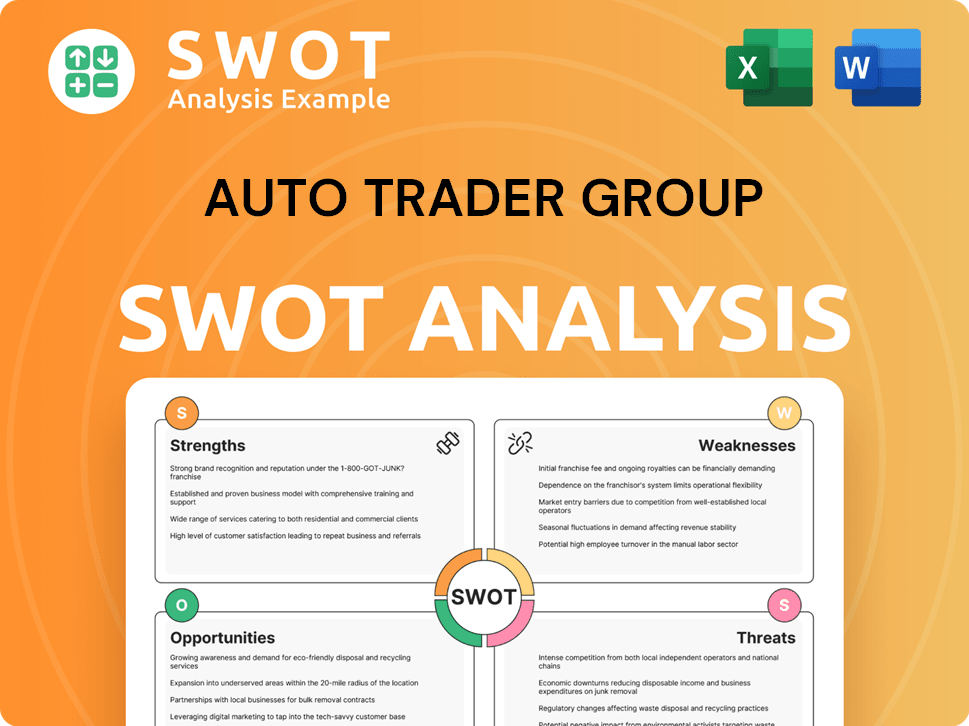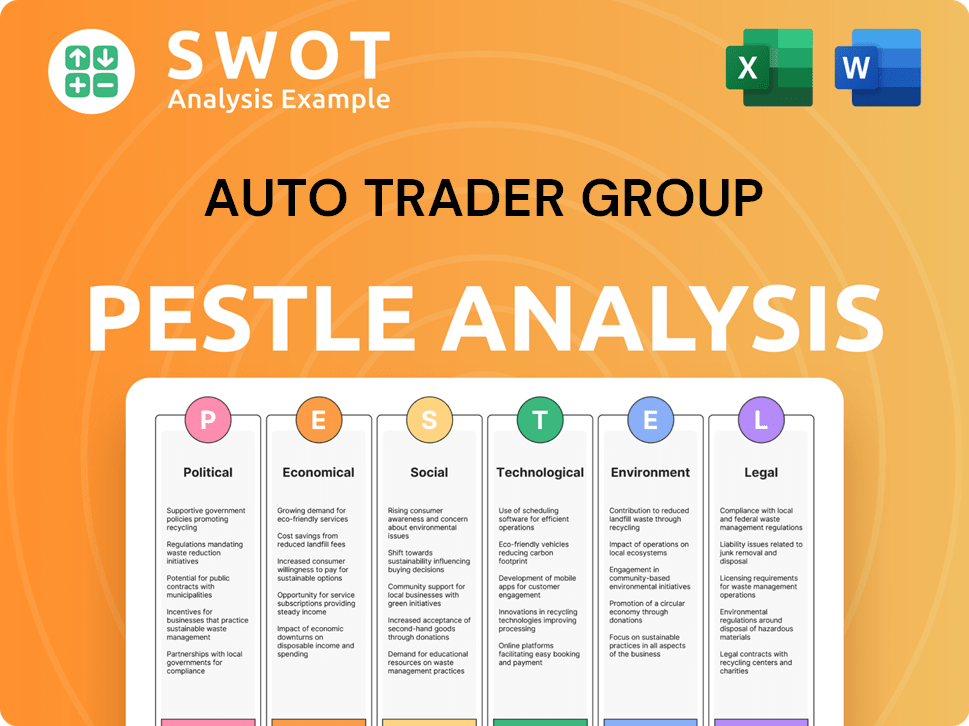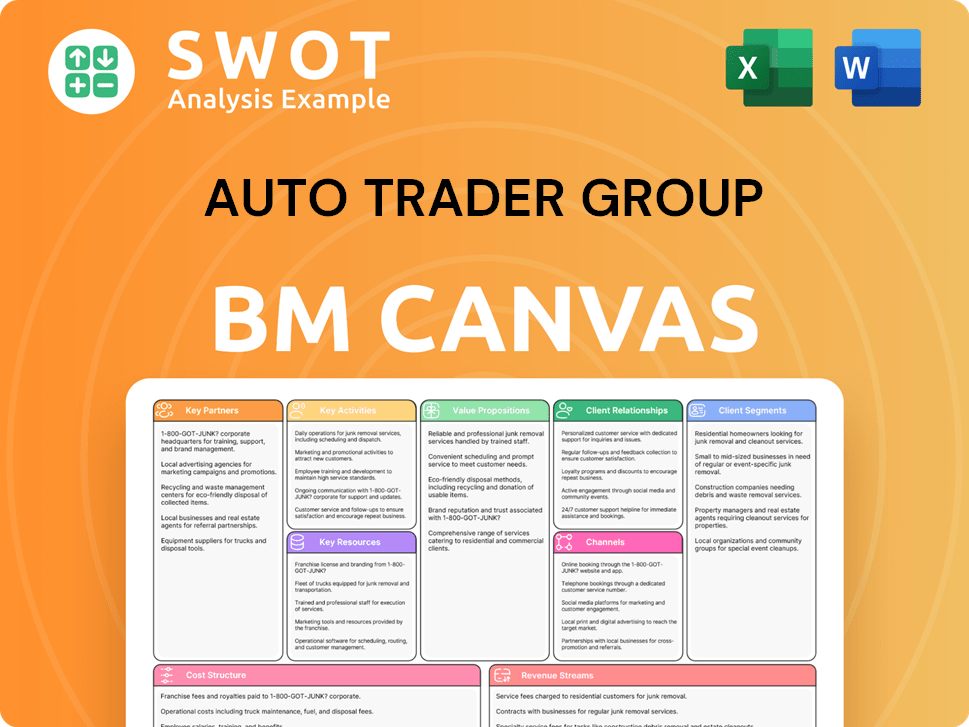Auto Trader Group Bundle
Can Auto Trader Group Maintain Its Dominance in the UK Auto Market?
The UK auto industry is undergoing a digital revolution, and at the forefront stands Auto Trader Group. From its origins as a print magazine to its current status as the UK's largest online car marketplace, Auto Trader has consistently adapted to changing consumer behaviors and technological advancements. This evolution has positioned the company at the heart of the auto industry analysis, but what does the competitive landscape look like today?

Auto Trader Group's impressive financial results, with revenue exceeding £600 million by March 31, 2025, highlight its resilience and strategic prowess in the competitive online car marketplace. To fully understand its market share and future potential, this analysis delves into Auto Trader Group's main competitors, Auto Trader Group SWOT Analysis, and the key factors driving its success. We'll explore how Auto Trader Group compares to rivals, examining its competitive advantages and the broader trends shaping the future of online car sales.
Where Does Auto Trader Group’ Stand in the Current Market?
The Auto Trader Group holds a commanding position in the UK's digital automotive marketplace. Its dominance is evident in its substantial market share, which is more than 75% of all minutes spent on automotive marketplaces in the UK. This strong market position is a key aspect of any auto industry analysis, highlighting its near-monopoly in online vehicle classifieds. The company's primary operations revolve around connecting consumers with retailers for buying and selling new and used vehicles.
The company's value proposition centers on providing a comprehensive platform for car buyers and sellers. It offers advertising and subscription services for car dealerships, vehicle valuations, finance options, and insurance. This integrated approach streamlines the car buying and selling process, making it easier for both consumers and retailers. The company's focus on innovation, such as the 'Deal Builder' product, further enhances its value proposition by offering integrated services.
Auto Trader Group's business model is primarily driven by advertising and subscription revenues from car dealerships. The company's financial performance underscores its ability to generate substantial revenue from its core marketplace operations. The company's growth is fueled by its ability to attract both consumers and retailers, creating a network effect that strengthens its market position. To learn more about the company, you can read Brief History of Auto Trader Group.
Auto Trader Group controls over 75% of the time spent on automotive marketplaces in the UK. This substantial market share indicates a strong competitive advantage. The company's size is more than 10 times larger than its closest competitor, reflecting its dominance in the online car marketplace.
For the year ended March 31, 2025, revenue increased by 5% to over £600 million. Core Auto Trader revenue saw a 7% increase, and operating profit before Digital Services Tax also increased by 7%. Average Revenue Per Retailer (ARPR) per month was up 5% to £2,854 on average for the year ended March 2025.
The average number of retailer forecourts advertising on Auto Trader increased by 2% year-on-year to 14,013 as of March 2025. This growth in retailer engagement demonstrates the platform's value and appeal to car dealerships. This increase supports the company's revenue model, which relies on subscriptions and advertising from these retailers.
The 'Deal Builder' product scaled to approximately 2,000 retailers by the end of March 2025. This product generated around 49,000 deals throughout the year, a threefold increase from the previous year. This innovation enhances the platform's appeal to both consumers and retailers, driving further growth.
Auto Trader Group's strengths include its dominant market position, strong financial performance, and innovative product offerings. These factors contribute to its competitive advantages in the online car sales market. The company's ability to attract and retain both consumers and retailers is a key driver of its success.
- Dominant Market Share: Controls over 75% of the time spent on automotive marketplaces in the UK.
- Strong Financials: Revenue growth of 5% and operating profit growth of 8% for the year ended March 31, 2025.
- Retailer Engagement: Increased number of forecourts advertising on the platform.
- Product Innovation: Successful launch and scaling of the 'Deal Builder' product.
Auto Trader Group SWOT Analysis
- Complete SWOT Breakdown
- Fully Customizable
- Editable in Excel & Word
- Professional Formatting
- Investor-Ready Format

Who Are the Main Competitors Challenging Auto Trader Group?
The Auto Trader Group maintains a dominant position in the UK's digital automotive marketplace. However, the competitive landscape is dynamic, with both direct and indirect competitors vying for market share. Understanding the challenges and opportunities within the auto industry is crucial for strategic decision-making.
While Auto Trader Group states it is significantly larger than its nearest classified competitor, the emergence of new business models and platforms poses ongoing challenges. This includes the growth of online car dealers and the increasing presence of new automotive brands. An in-depth auto industry analysis is essential to understand the evolving dynamics.
The competitive environment includes direct competitors, such as online car listing platforms, and indirect competitors, such as online car dealers and companies specializing in EV leasing. The increasing number of automotive brands also intensifies competition. For more insights, you can explore the Marketing Strategy of Auto Trader Group.
Direct competitors are primarily other online car listing platforms. These platforms compete directly with Auto Trader Group for listings and user traffic. While specific market share data for 2024-2025 is not available, these platforms are key players in the online car marketplace.
Cars.com, although with a broader international presence, is listed as an alternative to Auto Trader Group. The platform offers a wide range of listings and services, competing for consumer attention and dealer subscriptions.
Other platforms operating in the online vehicle classifieds space within the UK include Exchange and Mart, Motoring.co.uk, and Parkers. These platforms offer alternative listing options and compete for both consumer and dealer business.
Indirect competitors are shaping the competitive landscape by offering alternative ways for consumers to acquire vehicles or by targeting specific segments of the market. These players challenge Auto Trader Group's traditional dominance.
The rise of online car dealers, such as Cazoo, represents a different challenge. Although Cazoo has transitioned away from directly selling used car stock, its previous model and the broader trend of online car retail represent a shift in how consumers acquire vehicles.
Companies specializing in electric vehicle (EV) leasing, like Octopus Electric Vehicles, and fleet management solutions such as Unifleet, cater to specific segments of the automotive market. These companies indirectly compete for consumer attention and transaction volume.
The competitive landscape is further intensified by the increasing presence of new automotive brands. The number of new automotive brands in the market in 2025 increased compared to 2019, intensifying competition for advertising spend and consumer engagement on platforms like Auto Trader Group.
- Market Share: While specific competitor market share data for 2024-2025 is not readily available, the competitive landscape is constantly evolving.
- Online Car Sales Market Trends: The shift towards online car sales continues to influence the competitive dynamics, with more consumers and dealers adopting digital platforms.
- Impact of Digital Disruption: Digital disruption is transforming the auto industry, with online platforms playing an increasingly critical role in car buying and selling.
- Auto Trader Group's Strengths and Weaknesses: Understanding Auto Trader Group's strengths and weaknesses, such as its established brand and large user base, versus potential vulnerabilities, is crucial for strategic planning.
Auto Trader Group PESTLE Analysis
- Covers All 6 PESTLE Categories
- No Research Needed – Save Hours of Work
- Built by Experts, Trusted by Consultants
- Instant Download, Ready to Use
- 100% Editable, Fully Customizable

What Gives Auto Trader Group a Competitive Edge Over Its Rivals?
Understanding the Target Market of Auto Trader Group involves recognizing its robust competitive advantages within the auto industry analysis. These advantages stem from its strong brand equity, extensive market penetration, and technological prowess. The company's ability to innovate and adapt has solidified its position in the online car marketplace.
The competitive landscape for Auto Trader Group is shaped by its ability to maintain a dominant market share. This dominance is not just about size; it's about the strategic use of data and technology to enhance the customer and retailer experience. The company's focus on continuous improvement and strategic partnerships ensures its continued success.
Auto Trader Group's evolution from a print publication to a sophisticated digital platform showcases its adaptability and forward-thinking approach. Its sustained investment in technology and data analytics provides it with a significant edge over competitors. This approach allows the company to offer valuable tools to its partners, improving their efficiency and sales performance.
With brand awareness exceeding 90%, Auto Trader Group enjoys significant customer loyalty. This high level of recognition translates into consistent platform usage by both buyers and sellers. This strong brand recognition is a key factor in its competitive advantages.
The platform attracts approximately 81.6 million cross-platform visits per month as of March 2025. Over 75% of all minutes spent on automotive marketplaces are on Auto Trader. This vast audience and engagement create a powerful network effect.
Approximately 80% of UK automotive retailers advertise on autotrader.co.uk. This high level of retailer participation ensures a comprehensive selection of vehicles for consumers. This extensive retailer network is a crucial competitive advantage.
The launch of AI-enabled features like 'Co-Driver' in 2025 enhances the car buyer experience. The 'Deal Builder' product enables online part-exchange valuations, finance applications, and car reservations. These technologies are difficult for competitors to replicate.
Auto Trader Group's competitive advantages are multifaceted, encompassing brand recognition, platform scale, and technological innovation. These elements work synergistically to create a robust and defensible market position. The company's ability to leverage data further enhances its value proposition for both consumers and retailers.
- Dominant Brand Equity: High brand awareness and customer loyalty.
- Extensive Market Penetration: High percentage of UK automotive retailers using the platform.
- Proprietary Technology: AI-enabled features and tools like 'Deal Builder' enhance user experience.
- Data Insights: Market-leading retail valuations and insights through modules like 'Auto Trader Connect'.
Auto Trader Group Business Model Canvas
- Complete 9-Block Business Model Canvas
- Effortlessly Communicate Your Business Strategy
- Investor-Ready BMC Format
- 100% Editable and Customizable
- Clear and Structured Layout

What Industry Trends Are Reshaping Auto Trader Group’s Competitive Landscape?
The UK automotive industry is undergoing significant transformations, presenting both challenges and opportunities for companies like Auto Trader Group. Understanding the competitive landscape and market dynamics is crucial for strategic planning and sustained growth. This analysis explores key trends, future challenges, and potential opportunities within the context of the evolving auto industry.
The Auto Trader Group maintains a dominant position in the online car marketplace. However, the company faces evolving challenges, including increased competition and the need to adapt to changing consumer preferences and regulatory demands. The future outlook depends on the company's ability to leverage technological advancements, navigate regulatory changes, and capitalize on emerging market trends.
Technological advancements, especially in artificial intelligence (AI), are reshaping the industry. Regulatory changes, particularly the Zero Emission Vehicle (ZEV) mandate, are influencing market dynamics. Consumer preferences are shifting, with continued strong demand in the used car market.
The ZEV mandate, requiring a certain percentage of new car sales to be zero-emission vehicles, creates pressure. Potential threats include aggressive new competitors and evolving business models. Sourcing challenges for retailers are expected due to a low supply of 3-5 year old used cars.
Further digitalization of the car buying journey offers significant growth potential. There is potential to further monetize finance and other ancillary products. The company's strong data and technology capabilities position it well to adapt and provide value.
The used car market is forecast to grow by 1% in 2025, reaching 7.7 million transactions. New car registrations are expected to increase by 2% in 2025 to 1.98 million units. As of March 2025, Auto Trader's platform had 81.6 million monthly cross-platform visits.
Auto Trader Group's competitive landscape is influenced by technological advancements, regulatory changes, and evolving consumer preferences. The company must navigate the challenges of increased competition and adapt to the shift towards electric vehicles.
- Embrace AI: Leverage AI-enabled features like 'Co-Driver' to enhance the user experience.
- Adapt to ZEV Mandate: Monitor and adapt to the evolving ZEV mandate and its impact on the market.
- Capitalize on Used Car Market: Leverage the continued demand in the used car market.
- Digitalization: Further digitalize the car buying journey.
In conclusion, the Auto Trader Group faces a dynamic market environment. To understand the Auto Trader Group market position 2024, and how it compares to rivals, one should consider the company's ability to innovate and adapt. For a deeper understanding of the company's business model, consider reading Revenue Streams & Business Model of Auto Trader Group.
Auto Trader Group Porter's Five Forces Analysis
- Covers All 5 Competitive Forces in Detail
- Structured for Consultants, Students, and Founders
- 100% Editable in Microsoft Word & Excel
- Instant Digital Download – Use Immediately
- Compatible with Mac & PC – Fully Unlocked

Related Blogs
- What are Mission Vision & Core Values of Auto Trader Group Company?
- What is Growth Strategy and Future Prospects of Auto Trader Group Company?
- How Does Auto Trader Group Company Work?
- What is Sales and Marketing Strategy of Auto Trader Group Company?
- What is Brief History of Auto Trader Group Company?
- Who Owns Auto Trader Group Company?
- What is Customer Demographics and Target Market of Auto Trader Group Company?
Disclaimer
All information, articles, and product details provided on this website are for general informational and educational purposes only. We do not claim any ownership over, nor do we intend to infringe upon, any trademarks, copyrights, logos, brand names, or other intellectual property mentioned or depicted on this site. Such intellectual property remains the property of its respective owners, and any references here are made solely for identification or informational purposes, without implying any affiliation, endorsement, or partnership.
We make no representations or warranties, express or implied, regarding the accuracy, completeness, or suitability of any content or products presented. Nothing on this website should be construed as legal, tax, investment, financial, medical, or other professional advice. In addition, no part of this site—including articles or product references—constitutes a solicitation, recommendation, endorsement, advertisement, or offer to buy or sell any securities, franchises, or other financial instruments, particularly in jurisdictions where such activity would be unlawful.
All content is of a general nature and may not address the specific circumstances of any individual or entity. It is not a substitute for professional advice or services. Any actions you take based on the information provided here are strictly at your own risk. You accept full responsibility for any decisions or outcomes arising from your use of this website and agree to release us from any liability in connection with your use of, or reliance upon, the content or products found herein.